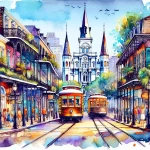New Orleans boasts a diverse cultural heritage interwoven from French colonial roots, Spanish influences, African traditions, and Creole culture. This blending created a distinct identity that still shapes the city today.
In This Article
TL;DR
- New Orleans’ unique character stems from the harmonious fusion of French, Spanish, African, and Creole cultures.
- Iconic traditions like Mardi Gras, jazz music, and Creole cuisine define the city’s vibrant identity.
- Historical events and cultural amalgamation have left an indelible imprint on New Orleans‘ ongoing practices.
The Founding of New Orleans: A Melting Pot Begins
In 1718, the French established New Orleans as a strategic port city along the Mississippi River, laying the foundation for a cultural melting pot that would shape its future. The city’s early years were marked by French colonial rule, which brought with it architectural styles, Catholic traditions, and a distinct joie de vivre.
However, in 1763, Spain took control of New Orleans, introducing Spanish colonial influences that further enriched the city’s cultural tapestry. This period saw the construction of iconic buildings like the St. Louis Cathedral and the Cabildo, blending Spanish and French architectural styles.
The Louisiana Purchase in 1803 marked a pivotal moment in New Orleans’ history, as the city became part of the United States. This transition brought an influx of Anglo-American settlers, further diversifying the city’s cultural landscape.
Cultural Synthesis: French, Spanish, African, and Creole Influences
New Orleans’ unique identity is a result of the harmonious blending of diverse cultures, including French, Spanish, African, and Creole influences. The city’s Creole population, descended from French and Spanish settlers, played a pivotal role in shaping the cultural and social life of New Orleans.
African traditions, brought by enslaved Africans and free people of color, left an indelible mark on the city’s music, cuisine, and festivals. The vibrant rhythms of jazz and the rich flavors of Creole cuisine are testament to the enduring influence of African culture in New Orleans.
Mardi Gras: The Epitome of New Orleans Traditions
Mardi Gras, the annual celebration of excess and revelry before Lent, is perhaps the most iconic tradition in New Orleans. Its origins can be traced back to the city’s French Catholic roots, with the first recorded Mardi Gras celebration taking place in 1699.
Over the centuries, Mardi Gras has evolved into a grand spectacle, featuring elaborate parades, colorful costumes, and the iconic krewes – social clubs that organize the festivities. The colors of purple, green, and gold, representing justice, faith, and power, respectively, have become synonymous with the celebration.
Jazz: The Soundtrack of the City
New Orleans is widely regarded as the birthplace of jazz, a musical genre that has captivated audiences worldwide. In the late 19th and early 20th centuries, the city’s vibrant melting pot of cultures gave rise to a unique sound that blended African rhythms, European harmonies, and the soulful expressions of the African American experience.
Legendary figures like Louis Armstrong, Jelly Roll Morton, and King Oliver helped shape the early jazz scene, laying the foundation for a musical tradition that continues to thrive in New Orleans today. From the iconic Preservation Hall to the lively clubs of Frenchmen Street, the city’s jazz venues keep this rich musical heritage alive.
Architectural Heritage: French Quarter and Beyond
The French Quarter, with its iconic wrought-iron balconies, colorful shutters, and hidden courtyards, is a living testament to New Orleans’ architectural heritage. The neighborhood’s buildings showcase a blend of French, Spanish, and Creole styles, reflecting the city’s diverse cultural influences.
Beyond the French Quarter, New Orleans boasts a wealth of architectural treasures, including the stately mansions of the Garden District, the grand St. Louis Cathedral, and the iconic Superdome. Preservation efforts have played a crucial role in maintaining the city’s architectural legacy, ensuring that these historic structures continue to captivate visitors and locals alike.
Culinary Traditions: More Than Just Gumbo
New Orleans’ culinary traditions are a delectable fusion of flavors from around the world. From the iconic gumbo, a hearty stew with African, French, and Native American influences, to the decadent beignets, a French-inspired fried pastry dusted with powdered sugar, the city’s cuisine is a celebration of its diverse cultural heritage.
Iconic dishes like jambalaya, po’boys, and bananas Foster have become synonymous with New Orleans’ culinary scene, reflecting the city’s love for bold flavors and rich ingredients. Today, a new generation of chefs is carrying on these traditions while also pushing the boundaries of Creole and Cajun cuisine, ensuring that New Orleans remains a culinary destination like no other.
Voodoo in New Orleans: Myth and Reality
Voodoo, a spiritual practice with roots in West African Vodun traditions, has been an integral part of New Orleans’ cultural fabric for centuries. Brought to the city by enslaved Africans and free people of color, Voodoo has left an indelible mark on the city’s folklore and traditions.
Key figures like Marie Laveau, the legendary Voodoo queen of the 19th century, have become part of New Orleans’ mythology, with her tomb in St. Louis Cemetery No. 1 attracting visitors from around the world. While modern-day Voodoo practices continue to evolve, the city’s tourism industry has embraced this mystical tradition, offering tours and experiences that explore the rich history and rituals of Voodoo in New Orleans.
Festivals and Celebrations: Year-Round Cultural Expression
New Orleans is a city that celebrates its cultural heritage year-round through a vibrant festival scene. From the world-renowned New Orleans Jazz & Heritage Festival, which showcases the city’s musical legacy, to the French Quarter Festival, a celebration of the neighborhood’s rich history and traditions, these events offer a unique opportunity to immerse oneself in the city’s cultural tapestry.
Other notable festivals include the Essence Music Festival, a celebration of African American music and culture, and the Crescent City Blues & BBQ Festival, which pays homage to the city’s love for blues music and mouthwatering barbecue. These festivals not only preserve and promote New Orleans’ traditions but also serve as economic drivers, attracting visitors from around the world and fostering a sense of community pride.
New Orleans’ rich tapestry of history and traditions is a testament to the city’s resilience, creativity, and unwavering spirit. From its humble beginnings as a French colony to its present-day status as a cultural mecca, New Orleans has embraced its diverse influences, weaving them into a vibrant and unique identity that captivates visitors and locals alike. Whether it’s the infectious rhythms of jazz, the decadent flavors of Creole cuisine, or the colorful spectacle of Mardi Gras, New Orleans’ traditions continue to thrive, ensuring that the city’s cultural legacy endures for generations to come.






